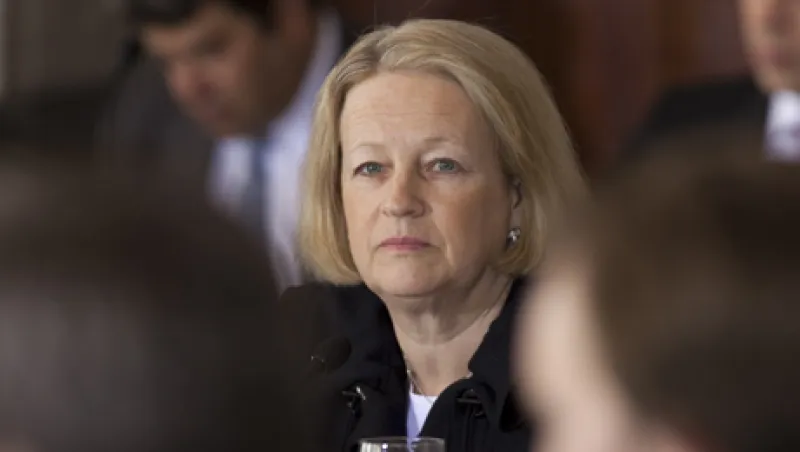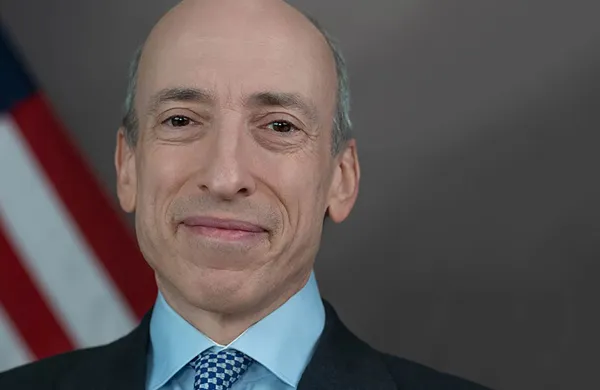The Securities and Exchange Commission’s plan to require money market funds to let their asset values float looks like it is dead in the water, judging from the SEC’s efforts to paddle away from the idea.
Even commissioners who are seen as supportive of the idea seem cowed by industry opposition. When SEC commissioner Elisse Walter, in a speech at the Investment Company Institute’s annual Mutual Funds and Investment Management Conference in Phoenix on March 19th, said she would speak on “a topic that is near and dear to your hearts and to mine — money market funds,” she also said she could “feel the oxygen leaving the room.”
Walter’s remarks followed those of ICI general counsel Karrie McMillan, who had termed the SEC’s plans for money fund reform “outrageous.”
What a difference a few months makes. Last November, SEC chairman Mary Schapiro made it known that the SEC was going to go for a second round of rulemaking on money market funds as a follow-on to the original reforms it adopted in February 2010. In a major speech at the Securities Industry and Financial Markets Association’s annual meeting in New York City, Schapiro said the first round of reforms had “tightened credit quality standards, shortened weighted-average maturities and, for the first time, imposed a liquidity standard,” but she described the stable $1.00 net asset value (NAV), which is unique to money market funds, as “brittle” and said the SEC was considering making money funds float their NAVs — like all other mutual funds — while also requiring them to institute “capital buffers, possibly combined with redemption restrictions.”
Schapiro ended her speech by stating, “And I look forward to sharing a reform proposal with you very soon.”
But it’s now five months later, and it looks like the mutual fund industry, led by the Investment Company Institute, has lobbied hard enough and well enough to win an indefinite reprieve.
Initially, “very soon” was understood by industry insiders to be by the end of March, but by now, “estimates of the first quarter have turned into springtime, sometime, and even that is sounding optimistic at this point,” says Peter Crane, the co-founder of Crane Data, the Westport, Massachusetts–based publisher of Money Fund Intelligence and other money fund products and publications.
“Nobody [at the SEC] is even clear on what they want to move,” says Crane.
Crane believes that “the path to compromise is pretty clear,” though he also believes it will take both sides “a while to realize that.” He thinks the solution is “an emergency redemption fee and a thin capital buffer.”
The problem with instituting a capital buffer — an amount set aside out of the yield of a money market fund to cover an unexpected run of redemptions, like a cushion of spare cash, so the fund can be self-supporting during a crisis and not rely on a subsidy from its sponsor — is that money funds are yielding an average of just six basis points.
Therefore, Crane believes that initially the capital buffer will be three basis points, which is still “asking an awful lot” in the current environment but “enough, to get the concept started, to get the buffer in place,” he says. “Once interest rates normalize, it can grow to 30 basis points, if rates are at three percent,” he says.
Crane also believes that the notion of restricting redemptions — where maybe three or five percent of an investor’s withdrawal of money from a fund would be subject to a hold of maybe a week or a month on a routine basis — is “silly, and not going to happen,” because “investors hate it, and the fund companies certainly hate it, too,” he says. He believes, however, that some sort of redemption fee or restriction “in case of emergency only” would be viable. “There would be some resistance, but it wouldn’t be a deal breaker,” he said. (Crane has always said that he believes a floating NAV is unlikely — “a long shot and a last resort.”)
Part of the industry’s lobbying effort is focused on showing just how well the 2010 reforms are working to increase liquidity. “It’s liquidity more than anything else that will deter runs,” said John Hawke, Jr., a lawyer with the Washington, D.C., law firm of Arnold & Porter, who has filed several lengthy comment letters on behalf of Federated Investors.
At that ICI conference in March, at the start of a panel discussion, ICI associate general counsel Jane Heinrichs led off with a series of slides that showed how money funds had changed since the adoption of the 2010 reforms.
First, she noted that even though yields were currently next to nothing, total fund assets were at $2.5 trillion to $2.6 trillion — down from the 2008 high of $3.8 trillion but comparable to the precrisis level of $2.5 trillion in June 2007, when yields were averaging 4.70 percent.
She then demonstrated how money market portfolios had become “more conservative” in their holdings. In 1995, 52 percent of their portfolios were invested in commercial paper, but by the end of 2011, that percentage had dropped to 25 percent, she said. The funds are now “holding a much higher percentage of their assets in highly liquid securities,” such as Treasury and agency securities, CDs, and repos “to accommodate shareholder redemptions,” she said.
The weighted-average maturities of all taxable money market funds are shorter, too, she said, noting that they were “hovering mostly between the 30- and 50-day range.” That is less than the 60-day maximum imposed by the 2010 reforms, which lowered the maximum from 90 days.
Most importantly, though, the 2010 reforms instituted requirements on daily and weekly liquidity for the first time. Heinrichs noted that during the week of September 15, 2008 — when Lehman Brothers failed and the Reserve Primary Fund “broke the buck” — prime money market funds experienced an estimated outflow of $310 billion. (“Prime” funds hold a mix of taxable, nongovernment securities.)
In comparison, taxable funds now hold an estimated $1.44 trillion in daily or weekly liquid assets, which includes $645 billion held by prime funds. That, Heinrichs’s slide noted, was more than two times the level of outflows experienced during “the worst week in money market fund history.”
So why push “reform” any further?
Schapiro has continued to voice her concerns in speeches.
Several days before the ICI event, she addressed the Society of American Business Editors and Writers annual convention in Indianapolis and noted that money fund managers “often go to great lengths to avoid breaking the buck,” by using their own capital or waiving investor fees to prop up the value of the funds. Schapiro noted that the SEC had allowed more than 100 funds to enter into capital support agreements with their parent companies in 2007–2008. Minus that, she said, other funds “might have broken the buck, kicking off other destabilizing runs.”
Schapiro is also fond of pointing out that when the 2008 run occurred, the U.S. Treasury was able to use the Exchange Stabilization Fund to guarantee money funds and stop the run, but Congress has eliminated that option. “Today, the money market fund industry, and by extension, the short-term credit market, is working without a net,” she said in another speech in February.
“I think Schapiro certainly wants to move something,” says Hawke.
But two SEC commissioners — Daniel Gallagher and Troy Paredes — are on record as being opposed to any further measures, and a third, Luis Aguilar, has voiced concern that further regulation might send investors to less-regulated investments, though he has not said how he would vote. With Walter expected to side with her, Schapiro needs at least one other commissioner to sign off on any newly proposed reforms.
There is also the possibility that if the SEC fails to act, the new Financial Stability Oversight Council (FSOC), established by the Dodd-Frank Act, could either designate specific funds as “systemically important” financial institutions or even say the funds generally were such.
But the industry may not sit still for that. At the ICI’s panel on money market funds, former SEC commissioner Paul Atkins, now with the consulting firm of Patomak Global Partners of Washington, D.C., said that if the FSOC were to act, the industry would sue. “I guarantee if they do act,” said Atkins, “there will be lawsuits.” Whether a body that includes the Fed and other bank regulators that have been pushing for such regulations will care as much about industry opposition as the SEC seems to do is another matter.






